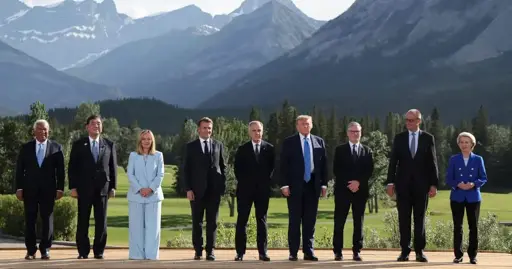Tehran “is the principal source of regional instability and terror,” declare G7 leaders in a joint statement.
The leaders of the G7 countries on Monday issued a joint statement saying Iran should not have nuclear weapons and affirming Israel’s right to defend itself.
“Iran is the principal source of regional instability and terror. We have been consistently clear that Iran can never have a nuclear weapon,” declared the statement, issued by the leaders of the U.S., U.K., France, Germany, Italy, Canada and Japan, along with the EU.
They pledged to “remain vigilant to the implications for international energy markets and stand ready to coordinate, including with like-minded partners, to safeguard market stability.”



found a few familiar resources in iran that the western world and its allies would love to gain full control of.
Oil Due to the vast quantities of crude oil reserves within Iran, the nation is considered an energy superpower. According to official records from the Iranian government, in 2006, the crude oil reserves in the nation were estimated to be 132.5 billion barrels. At the time, Iran’s reserves were estimated to be 15% of the total reserves of all the members of the organization of petroleum exporting countries. In comparison to the rest of the world, Iran’s 2006 oil reserves were approximately 11.4% of the global reserves. After the discovery of oil reserves around the town of Bushehr, the oil reserves in Iran increased by roughly 32%. According to the International Monetary Fund, the monetary value of Iran’s oil reserves was estimated to be $10 trillion. The Iranian government entered into several agreements with oil companies from a variety of nations such as the United Kingdom, Russia, the Netherlands, and Spain to develop the oil reserves. Several oil refineries are situated within Iran’s boundaries with the most prominent being Abadan, Esfahan, and Bandar-e Abbas. The main method of transporting Iranian petroleum is through the pipeline. According to a study carried out in 2004, pipelines in Iran transported roughly 69% of the refined petroleum products.
Natural Gas Iran also has massive reserves of natural gas that according to official government records are estimated to be 1,201 trillion cubic feet. Iran’s reserves are some of the largest in the world as they account for close to 18% of the world’s total. The only nation with larger gas reserves than Iran is Russia. In 2011, the Iranian petroleum minister released a report indicating that Iran’s reserves of natural gas had increased significantly due to the discovery of gas reserves within the Caspian Sea. The Caspian reserves were estimated to be 50 trillion cubic feet. Iran is currently exploiting a limited amount of its natural gas reserves, and on average it exploits 5.5 trillion cubic feet annually. The Iranian government has planned to invest huge sums of money in improving the gas industry. The government has planned to set aside $15 billion every year to increase the annual natural gas production. The Iranian government is planning to take advantage of the increase in the demand for natural gas all over the world. Estimates indicate that over 20 years the global demand for natural gas would increase by either 2% or 3%. Some of the main markets for Iranian natural gas include China and india